You may have heard about the brutality of helicopter roundups of our nation’s wild horses, but most people never get to see them first-hand. We monitor these roundups and bring you a first-hand eyewitness account of what wild horses and burros endure. In Defense of Animals will continue to bear witness and speak out for these innocent sentient beings.
Unnecessary “Emergency” Roundups
Often the Bureau of Land Management (BLM) holds what it calls an “emergency” roundup of America’s wild horses and burros because that label enables the agency to capture as many horses as it wants without the need for any public input. Of course, this means the agency must come up with an “emergency” to do so and it is adept at fabricating reasons to avoid public scrutiny. One such circumstance was the roundup of the horses in the Piceance-East Douglas Herd Management Area (HMA) in western Colorado in July 2022.
Horse Roundup Observation at Public Sites
Ginger Fedak, our Wild Horse and Burro Senior Campaigner at In Defense of Animals, has attended devastating wild horse roundups to bear witness and advocate for these iconic animals. To let our supporters know what it is like to witness a roundup, and the heartbreaking emotional experience it is, she has provided an account of one recent roundup below:
Usually, the BLM puts public observers at a designated site over a mile from the trap site. The observation site for the first four and a half days of the Piceance-East Douglas roundup was fairly close to the trap. However, the BLM works hard to ensure there are obstructions and other factors so that public observers cannot see much. In this case, we public observers could not see helicopter chases leading up to the trap. We also couldn’t see into the full trap due to trees and high sagebrush, a purposely-situated trailer in front of the loading chute, and webbed covering on the sides of the panels. I climbed onto a fallen tree to try to get a better (higher) view. It didn’t help much.
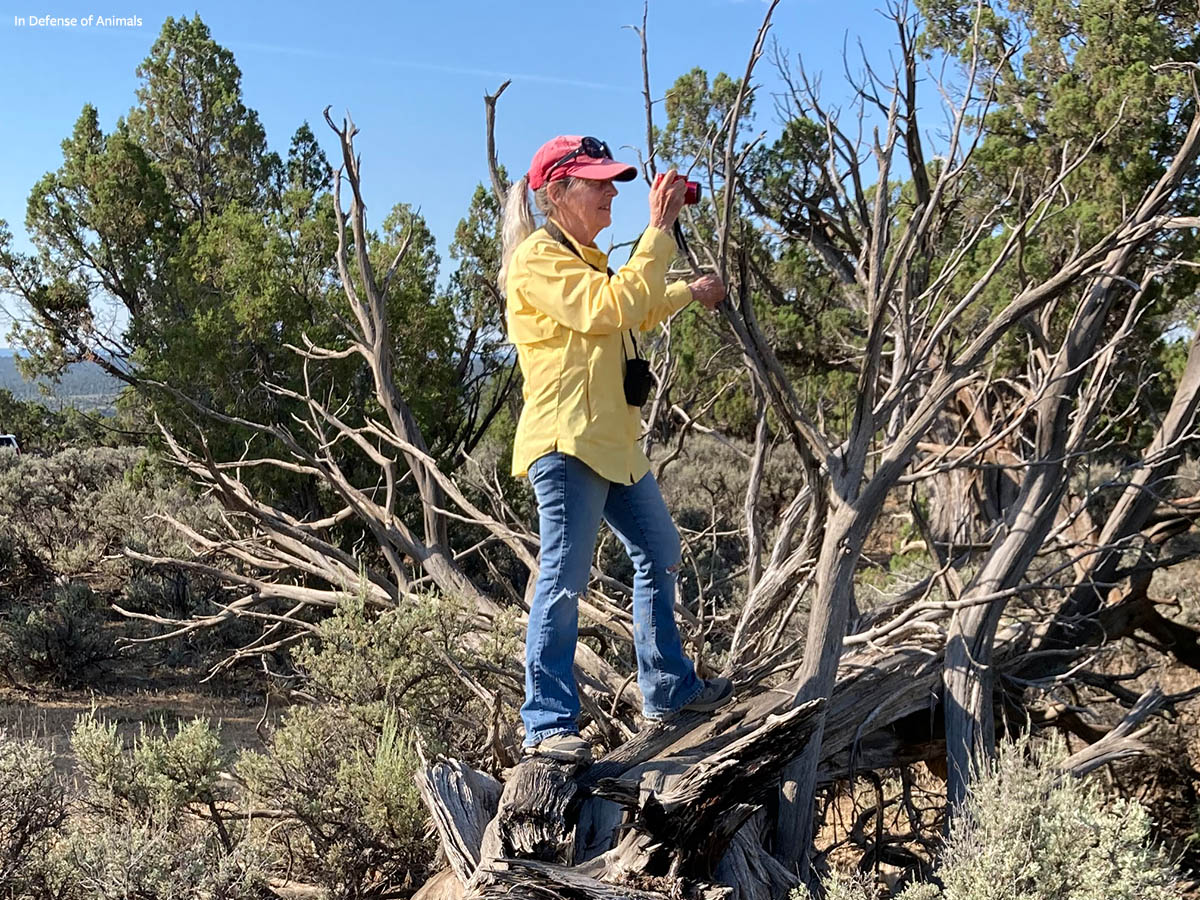
Before the helicopter began to bring the horses in, and before they raised the jute “fencing” along the sides of the run-in, the public observers were allowed to go see the trap. This photo shows how small the trap is that the horses gallop into, risking devastating injuries.
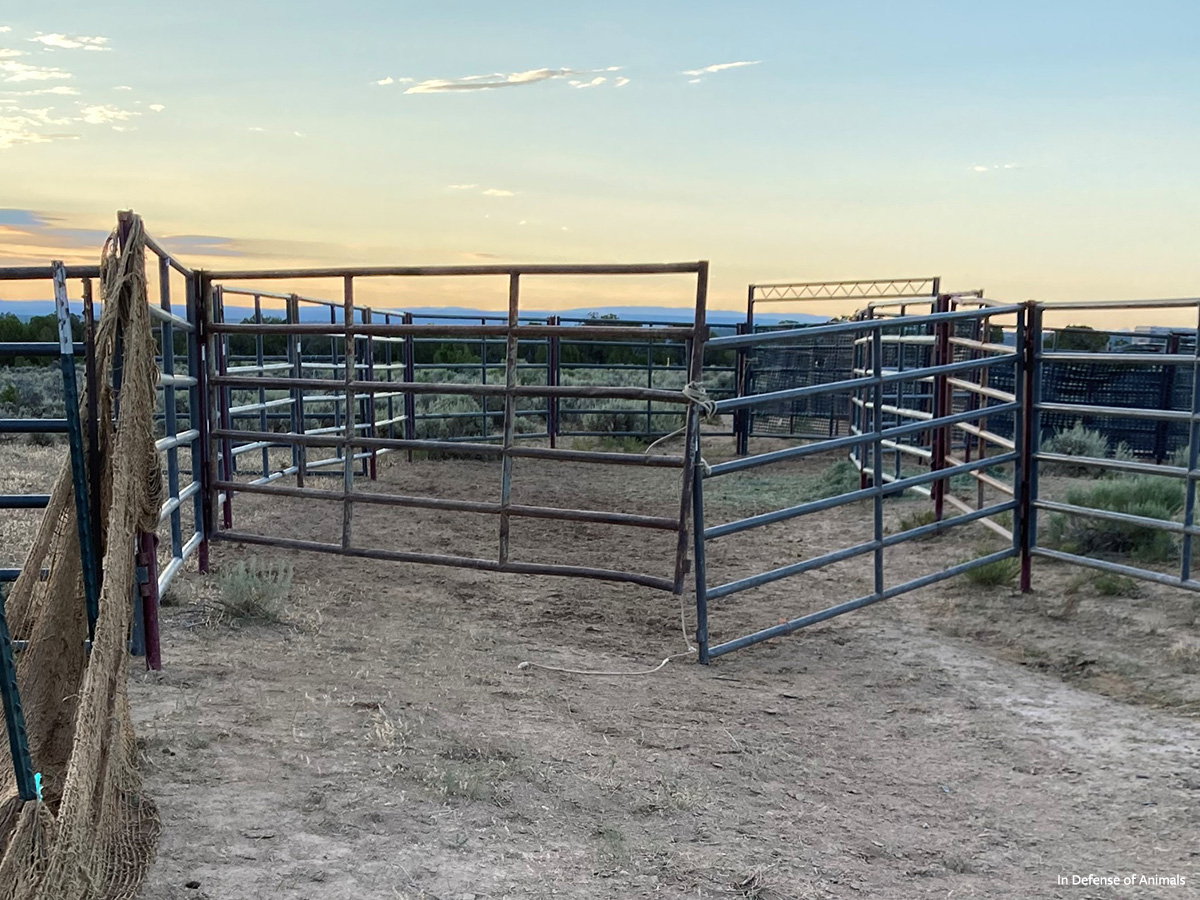
The BLM is very restrictive regarding where observers may stand at roundup public observation sites. It claims it is for the safety of the observers and the horses. To knowledgeable horse people, the restrictions and reasons given are ludicrous. It is apparent that the overly-strict limits are in place to prevent the public from seeing and photographing what goes on during the chase and at the trap. At this site, public observers were told to stay behind a specific invisible line and sheltered from the horses’ view behind a tree when the helicopter brought the horses to the trap.
The zoomed-in photo below was taken from a spot behind a tree, and well behind the invisible line we were ordered to stay behind. The next day when I went to this very same spot, I was told by the BLM staffers that I couldn’t stand there! I explained I had been there the day before and was well hidden behind a tree from the horses’ view. They claimed that they hadn’t seen me there or they would have made me move. Obviously, this spot gave a view the BLM did not want us to have, and one that we could not get from the small area where the public was allowed to stand.
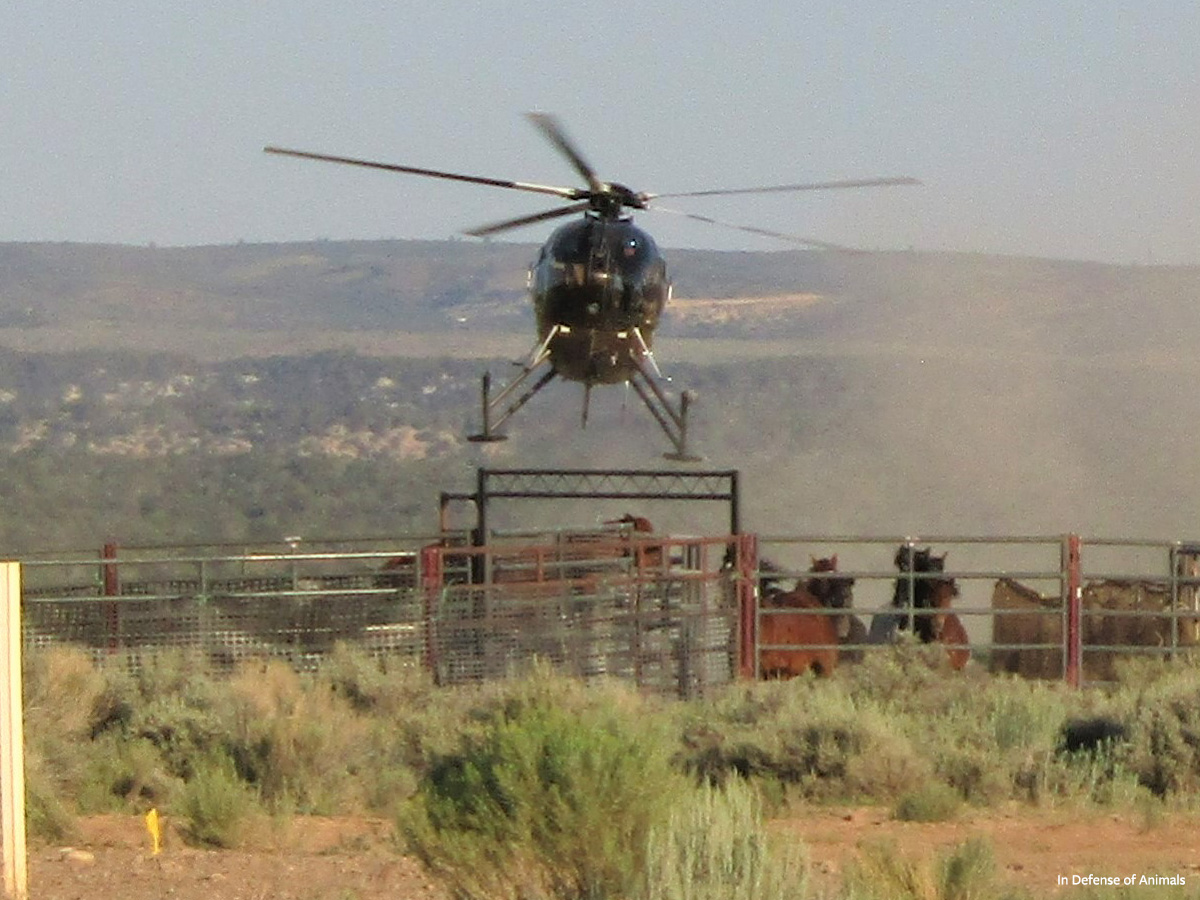
Ground Conditions at the Mustang Roundup
At every trap site and on every day of this roundup, conditions were terrible for the helicopter chase of these horses. Temperatures every day rose into the 90s. Observers took cover in what shade they could find in the sweltering heat, but the horses had no such advantage. They galloped for many miles, twisting and turning while trying to evade the flying mechanical beast.
Besides the extreme heat, the horses, including very young foals, also had to gallop over rocky and rough ground, often jumping over sagebrush as they ran. Six deaths were recorded by the BLM.
Chaos in the Horse Traps
Horses captured in the tiny trap are terrified and crammed together, causing stressed-out tempers to flare, as in the photo below. Observers could only get this view of more than the horse’s heads because they were rising on their hind legs here.
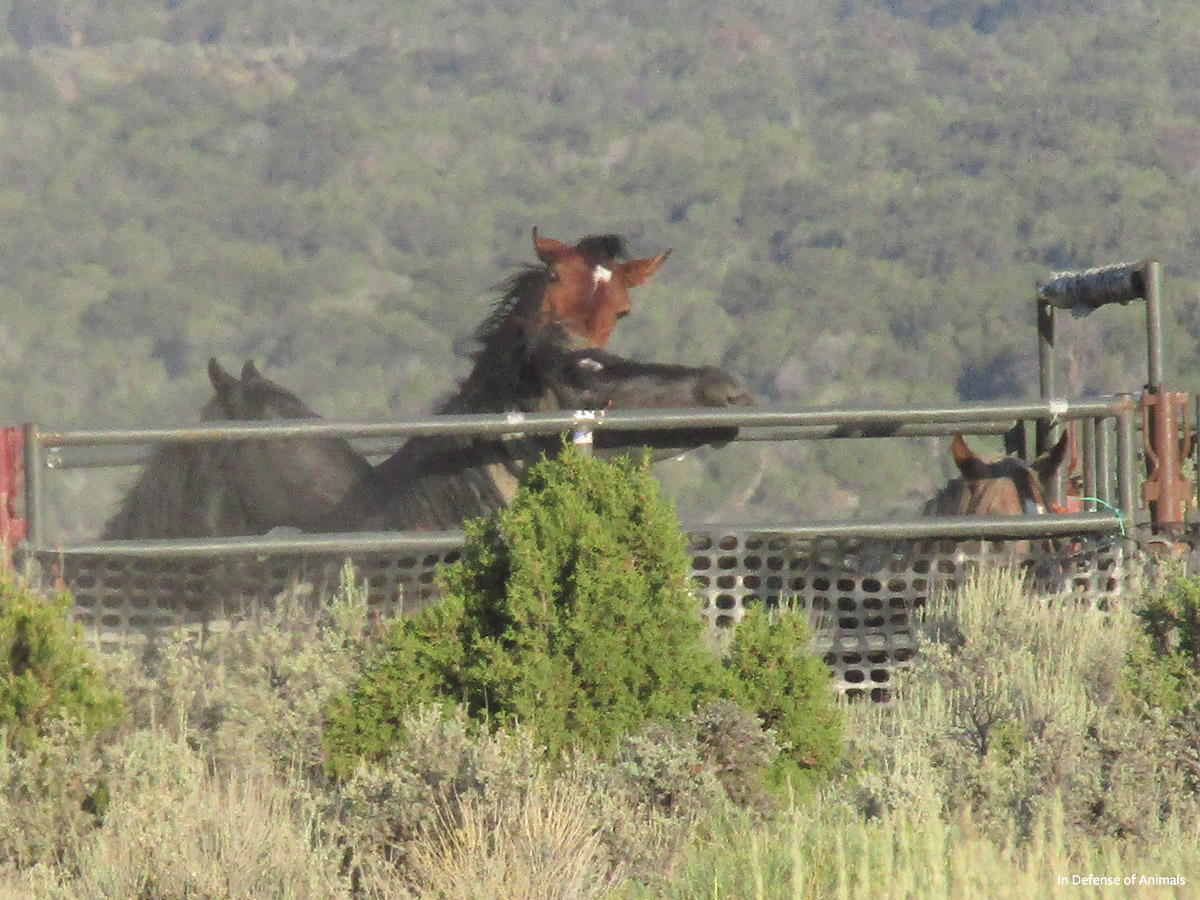
After the horses are chased into the small initial trap, they are pushed through tiny passageways between the panels toward the loading area, where they are then moved into trailers. The horses are moved by personnel aggressively waving plastic bags on long sticks, which scares the horses to go in the opposite direction. The trailers then haul the horses to a temporary holding facility for sorting.
Temporary Holding Pens Prior to Shipping
At this roundup, because the BLM and helicopter contractor (Cattoor Livestock Roundup Co.) put the temporary holding pens on private land, the public observers had no opportunity to view the horses after they were captured. The horses were quickly loaded up from the daily trap sites and trailered away to the hidden-from-view private property pens. After a day or so at the temporary holding pens, they were loaded onto trailers for the journey to a private off-range corral facility in Axtell, Utah.
At some roundups, like the Sand Wash Basin roundup we attended the previous year, the public observers are allowed to go to the temporary holding pens at the actual trap site to see the horses before they are shipped to their official short-term holding destination. This happens after the helicopter stops for the day and the contractors and BLM staffers have separated the horses into pens according to age and gender. Efforts are made to keep mares and nursing foals together, but sometimes young foals are left behind and alone on the range because they cannot keep up with the madcap chase. In the pens, family band members are broken apart. Stallions and mares call for each other in distressed anguish.
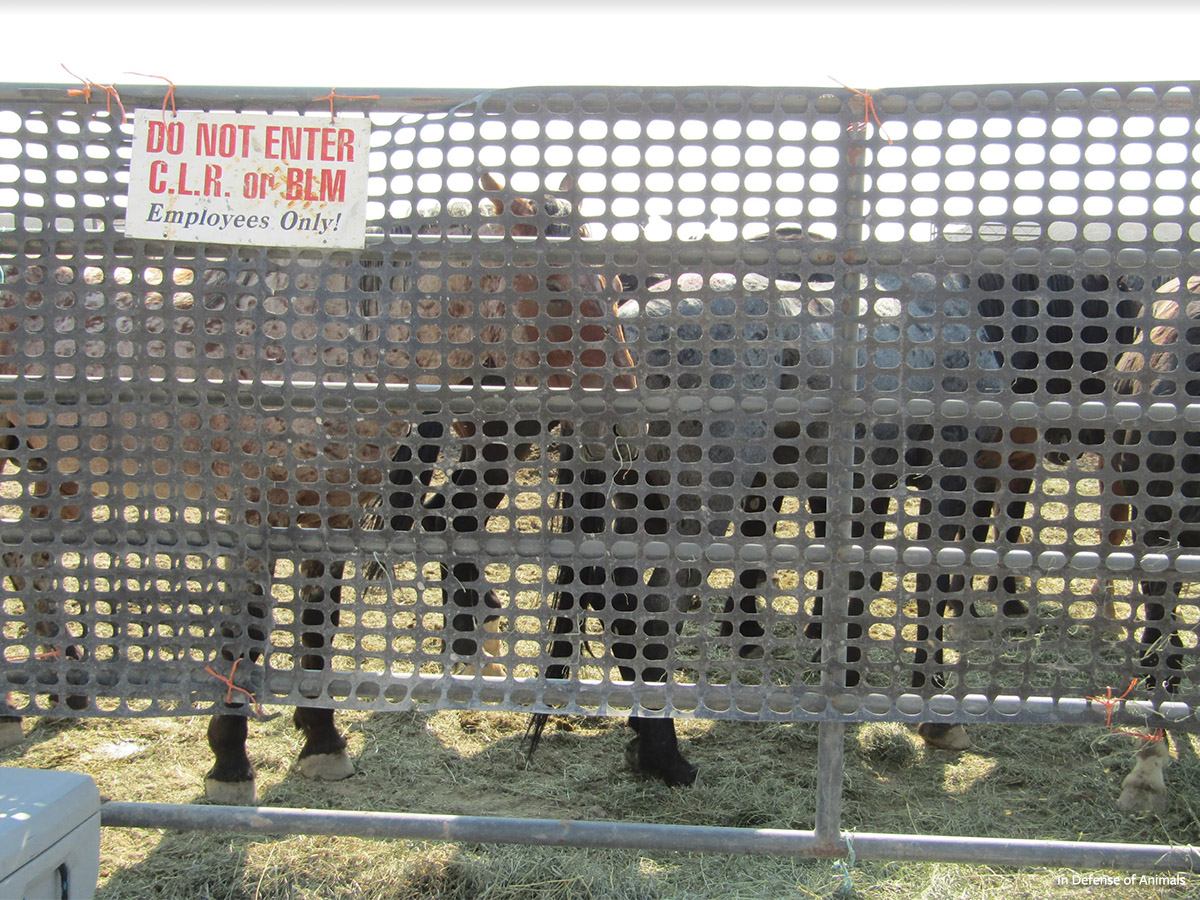
For this Piceance roundup, there was no reasonable explanation that the BLM staffers would give us as to why the temporary pens could not have been put up at the trap site so that the public could get closer to see the horses. The reason evident to us was that the BLM did not want the public observers to see how sweaty and distressed the horses and foals were after being chased for many miles in temperatures well into the 90s. Running over rough ground, they had to jump over sagebrush and run up and down hills, gullies, and washes at breakneck speed. These terrorizing chases can last over an hour. Think about a Kentucky Derby racehorse drenched in sweat and heaving heavily after galloping for only two minutes!
An Unusual Opportunity To Go Into the HMA Between Trap Set-Ups
During wild horse roundups, the public is not allowed in the HMA except at the small designated observation area. Public observers must meet BLM staffers and at least one armed security deputy, in the dark, at a pre-dawn meeting spot in a nearby town. The public observers then sign in and follow their BLM escorts to the observation area in a short or long cavalcade, depending upon the number of observers for that day. They then must stay in that small area until helicopter operations for the day are over.
On the mid-morning of the fifth day of the roundup on July 19, the BLM and the helicopter contractor decided to move the trap site to a new location. During the break in operations, other observers and I went into the HMA to look for horses. We found them all looking extremely healthy and in optimum condition. Their good form directly contradicted the BLM’s assertion that they had to round up the horses in the hottest month of summer because of their poor condition.
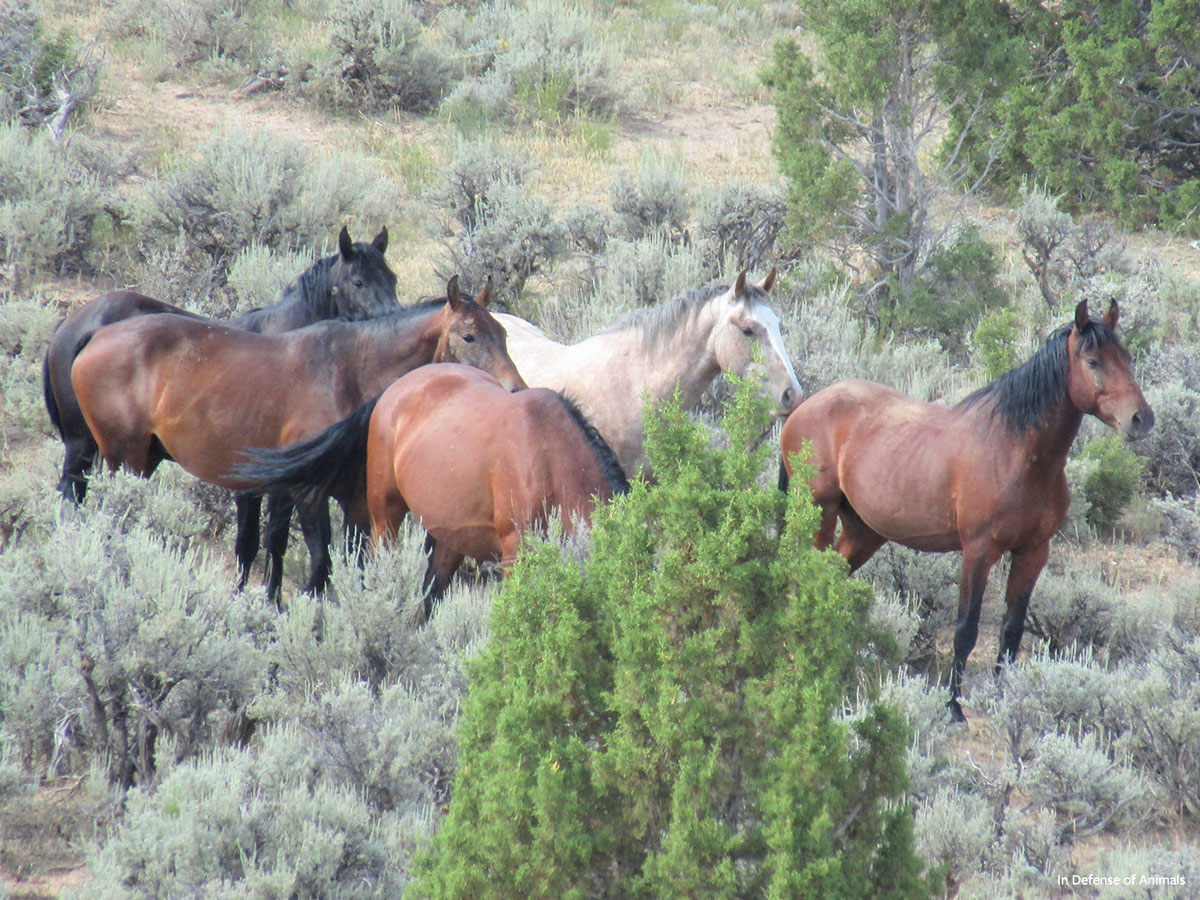
A reporter and photographer for the Steamboat Pilot were among the observers the day we were allowed into the HMA. They were there to cover the story. They also could see firsthand the excellent condition of the horses. We never saw a thin or unhealthy horse.
More photos of this roundup can be seen on the Steamboat Pilot’s website.
Second Trap Site and Tortuous Road To Get to It
Very little could be seen from the second site set up on that same afternoon. The helicopter chase was well over a mile away. The trap site was also at least a mile away, and the chute funneling into the trap was hidden behind trees to the left of a gas pad.
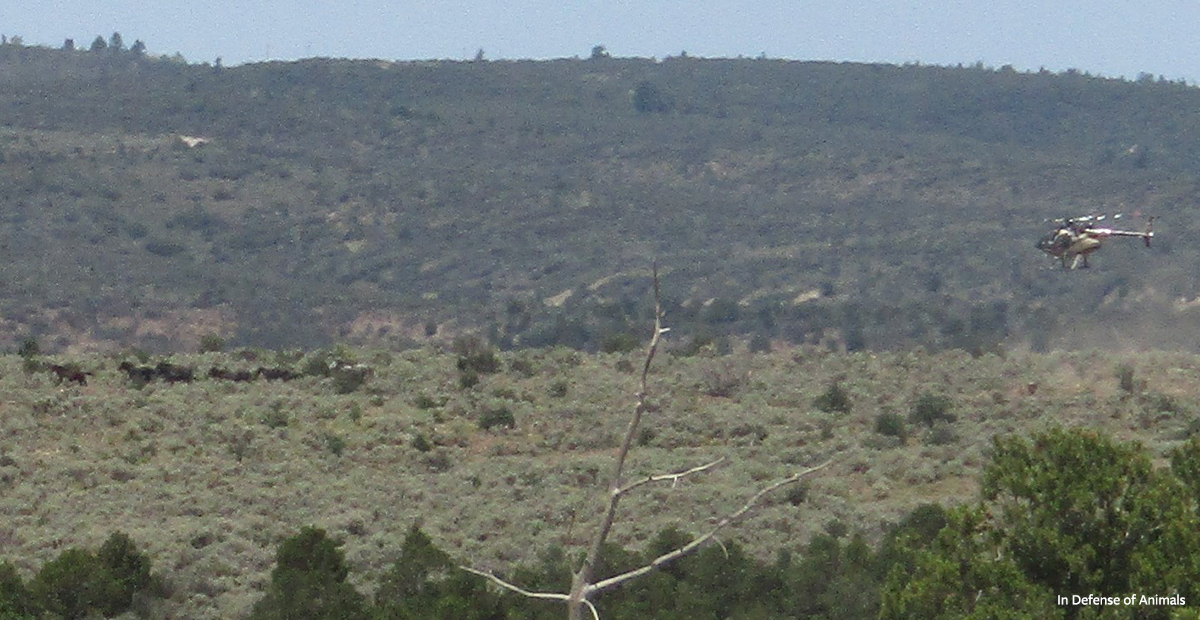
The eight-mile stretch of road to get to the trap site from the paved road was so rutted and chunked out that it took out a skid plate on my car. This was the same road the horses had to be trailered out of the HMA! It had to be a tortuous ride for the horses as they were slammed around in the trailer going down that “road” that was extremely jarring — even in my SUV with good suspension.
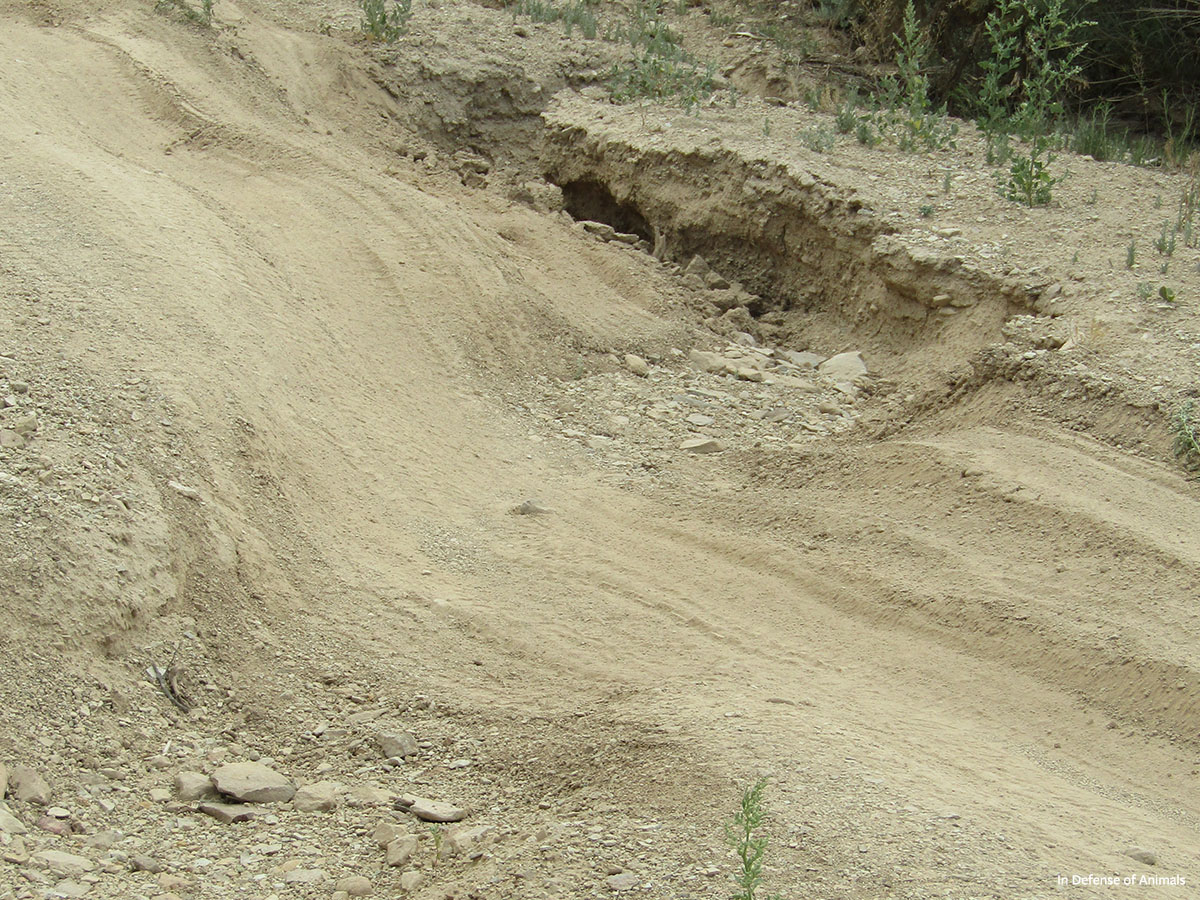
It was bad enough for the adult horses crammed into the main part of the trailer. If you look closely at this trailer photo and zoom in, you can see a tiny, very young, light-colored foal in the back section with nothing to steady herself. You can see the baby with nose to the floor and legs splayed wide, trying to brace herself in the back of the trailer — before it even got to the road’s terrible part. I’m sure that baby was thrown down and knocked around horribly for at least 40 minutes until the trailer got to the paved road.
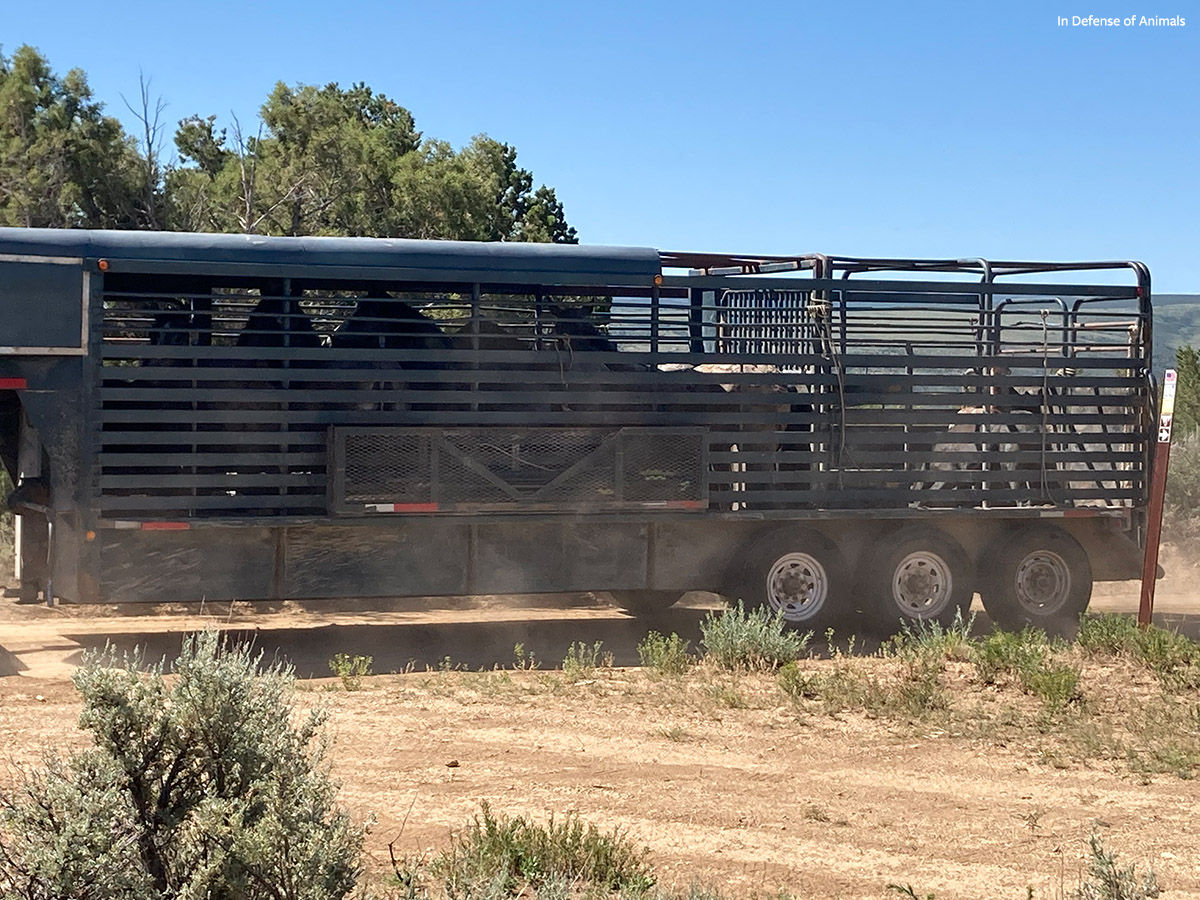
I told the BLM staffers at the observation site about how bad the road was and said they shouldn’t be taking trailer loads of horses over it because it was too dangerous. I was met with blank stares, asking if I was serious. Some of these people, whose salaries we taxpayers pay, are incredulous that we believe wild horses have feelings and suffer. It is maddening. I will never know if that baby made it down that steep and jolting road alive.
Third Wild Horse Trap Site
The second trap site was used for only a day and a half on days five and six of the roundup. Staffers told us it was moved to a new location because the helicopter pilot couldn’t find enough horses or chase them out of the trees there. That may have been the reason. Or perhaps my complaints and concerns to both the staffers and the newspaper reporter there about the horrible road the horse trailers had to go down had them thinking twice about what might come out in the press if too many horses were injured on that ride down the steep, rutted road.
On roundup day number seven on July 21, our observation point had the best view of all previous days because we could see both the last part of the chase and the trap itself. However, the accessibility was terrible.
To get to the observation point, we had to climb up a steep cliff without good hand holds or foot holds, and lots of loose scree and falling rocks. Fortunately, I have Colorado Mountain Club and rock climbing experience, so I could get to a decent sightline point. In the first photo, you can see the blue cap on one observer’s head below a steep drop-off, with the dirt road far below that. In this first photo, I am helping Kati Weis of Channel 4 News (Denver CBS station) try to set up her camera on the slanting, loose ground.
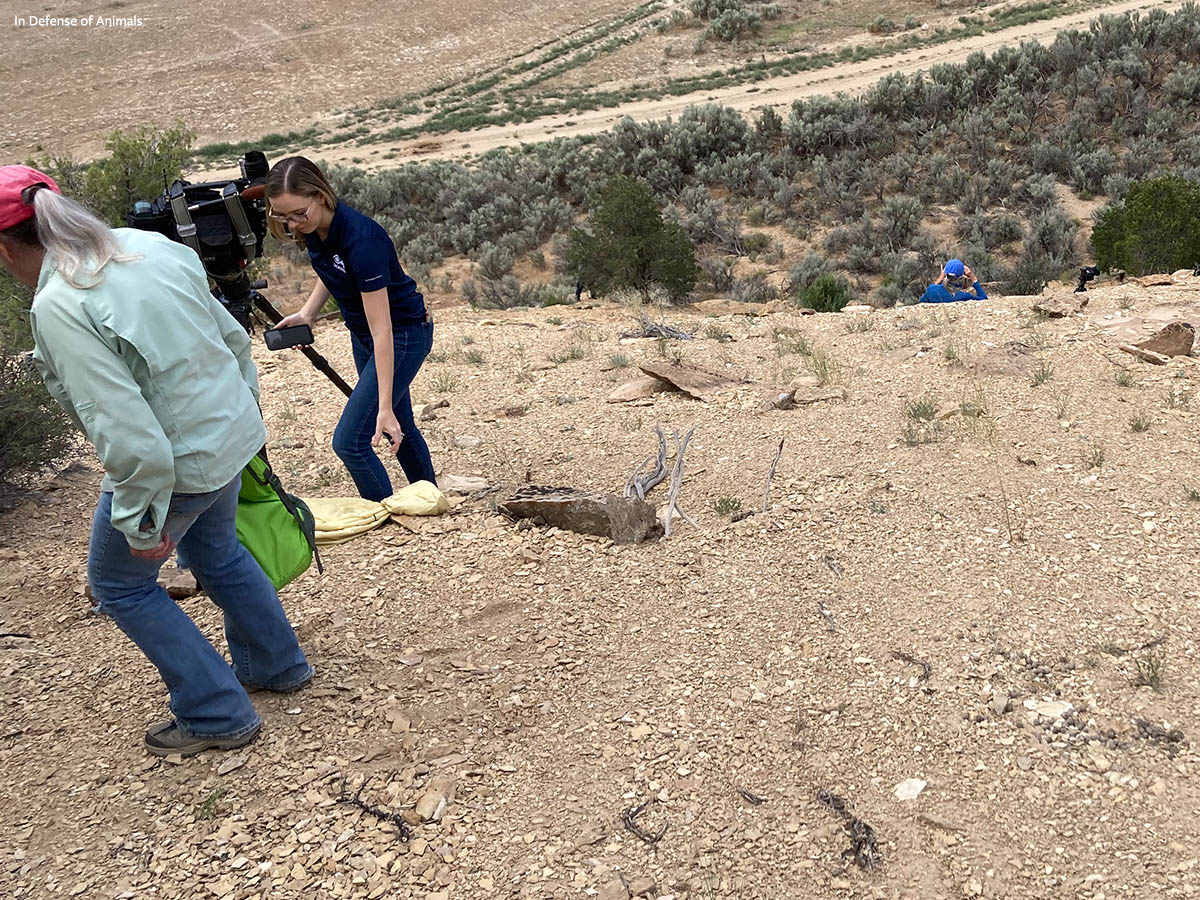
The next photo shows our view of the trap site and the road the horses were chased down to approach it.
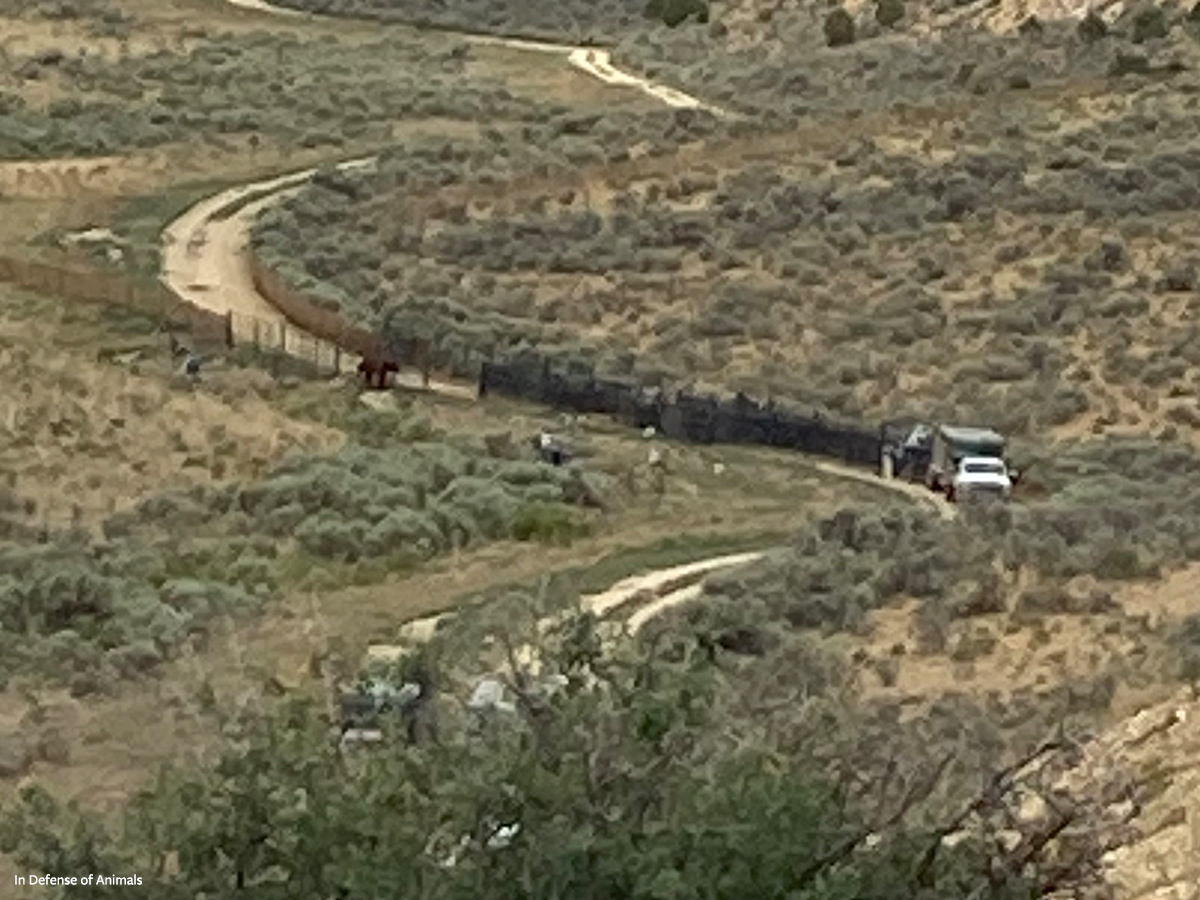
The trap site was still very far away, and little could be seen with the naked eye. In the zoomed-in photo, you can barely see the horses’ heads above the trap walls.
On this seventh day of the roundup, several BLM officials showed up because they knew a TV news reporter would be there. Of course, they wanted to give the reporter the BLM “spin” and propaganda to attempt to legitimize the roundup. I took advantage of the fact that the BLM’s then-acting Colorado state director, , Stephanie Connolly, was there to ask her some questions. She “doubled down” on the need for the emergency roundup when I asked her why they moved it from September to the heat of July with so many very young foals. I questioned their use of the report of thin horses they put out in early March when they are naturally thin coming out of winter. I said this is a natural cycle that wild horses go through every year, and they are all fat and healthy now. Why round up now instead of September? She tried to explain it as being concerned with the thin mares not having enough milk for their foals back in March, carrying it forward to the summer months. Not only is this claim baseless and illogical, but photographic evidence shows that the mares were fat, healthy, and the foals robust at the time of the roundup.
Piceance Wild Horse Roundup Ends Early
The BLM planned to capture a staggering 1,050 members of the Piceance herd, including stallions, mares, and foals. Operations were concluded after it trapped 867. Six wild horses died in the operation, including three foals. Untold numbers were physically injured, and every single horse suffered extreme stress during the roundup, separation, and transport to longer-term holding.
When the roundup ended early, almost 200 horses were spared from the agony of capture and separation from family and all they hold dear. This action could very well be due to pressure put on the BLM, showing that activism can make a difference. Advocacy organizations, including In Defense of Animals, worked tirelessly to expose the misrepresentations and problems with this roundup. We were fortunate to also have the support of political figures in Colorado who listened and spoke out to urge a better way to steward Colorado’s wild horses. Gov. Jared Polis, First Gentleman Marlon Reis, and Congressman Joe Neguse all called for an end to the roundup.
Why Are Wild Horses Rounded Up?
Why does this abhorrent practice of roundups and removals continue? The Wild Free-Roaming Horse and Burro Act of 1971 protected wild horses and burros on public land designated for their “principal use.” Yet, in most HMAs, wild horses and burros get far fewer resources than other users on the land. The Piceance HMA is a prime example of this, where cattle ranchers and extractive industries use our public land for personal gain, whilst wild animals who are supposed to enjoy special protections pay the price.
Livestock ranchers want our public land resources for their own exploited animals. Cattle ranchers use our public lands in the Piceance HMA.
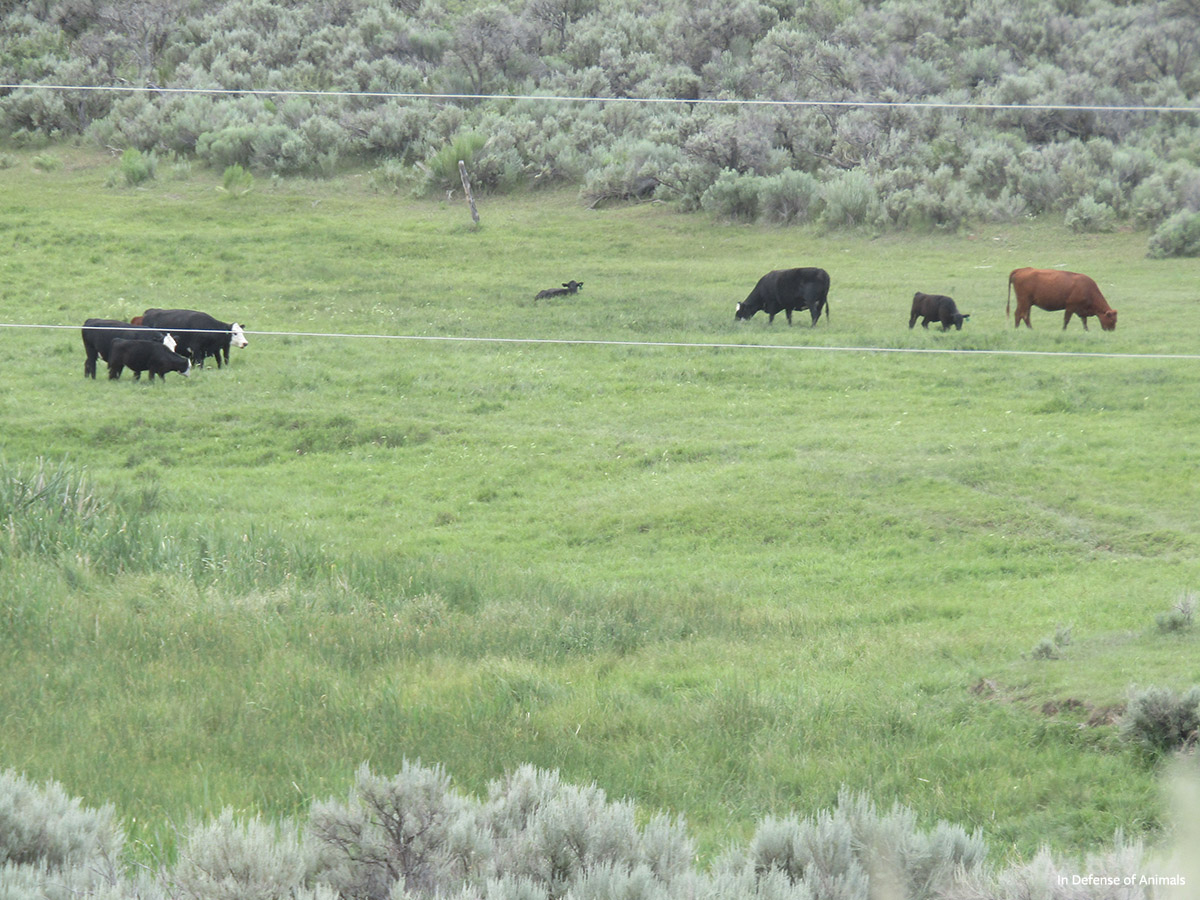
Extraction industries are prevalent in the Piceance HMA, including oil and gas wells and mining operations. Their trucks rumble over the roads creating dust clouds in their wake.
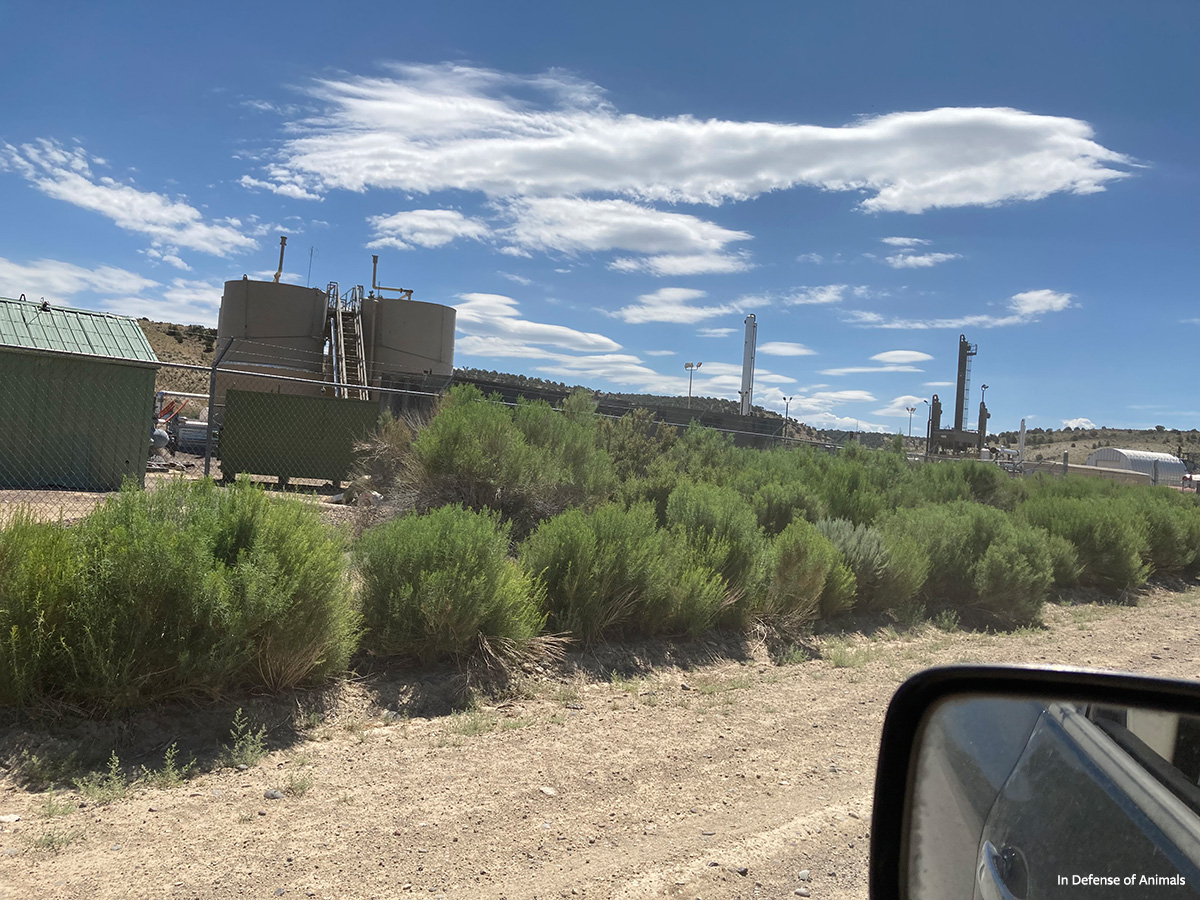
It is a heartbreaking experience to witness a roundup and the accompanying loss of freedom, injuries, and even death for these horses. Family bands are separated forever, which is traumatizing to them and caring observers. After roundups, the horses languish in holding facilities that are nothing more than crowded dry lot pens with no shelter from the elements. Horses spend many months in these pens, sometimes well over a year, with the light and life in their eyes gone as they succumb to hopelessness.
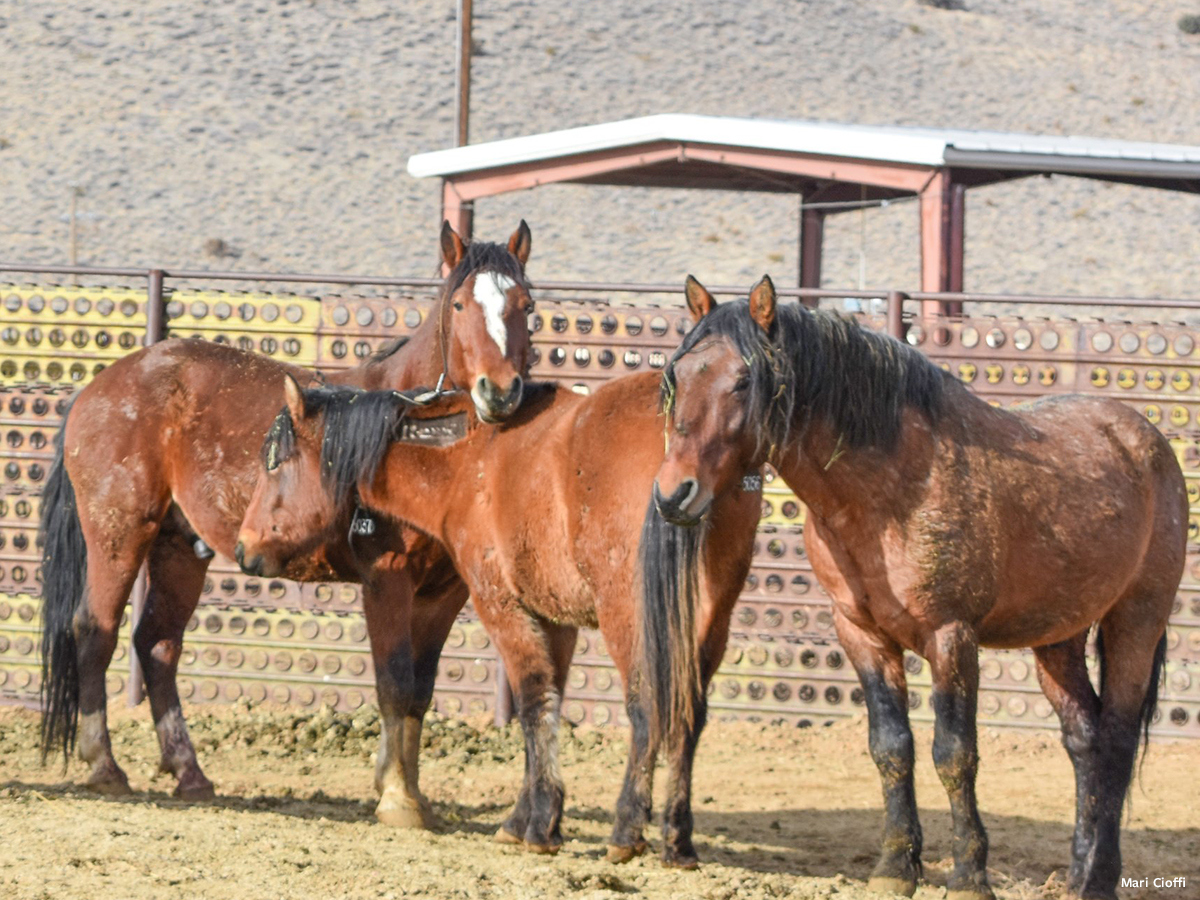
The Aftermath of the Mustang Roundup
Some “lucky” animals rounded up go to adoption or auction events and new homes or sanctuaries. Others end up in privately-owned, government-contracted, long-term holding pastures with no public transparency. Some end up in the slaughter pipeline, shipped to slaughter plants in Mexico and Canada. In Defense of Animals works hard to end this sinister cycle.
The first adoption/auction event for the Piceance horses rounded up in July was held in Grand Junction, Colorado, on November 5, 2022. Only 34 geldings (neutered male horses) were brought to the event from the holding facility in Axtell, Utah. Initially, 70 Piceance horses, including geldings, mares, and weanlings, were supposed to be there. Unfortunately, some of the mares at the Axtell facility had runny noses. In a display of caution, no mares or weanlings from the mare pens were at the event.
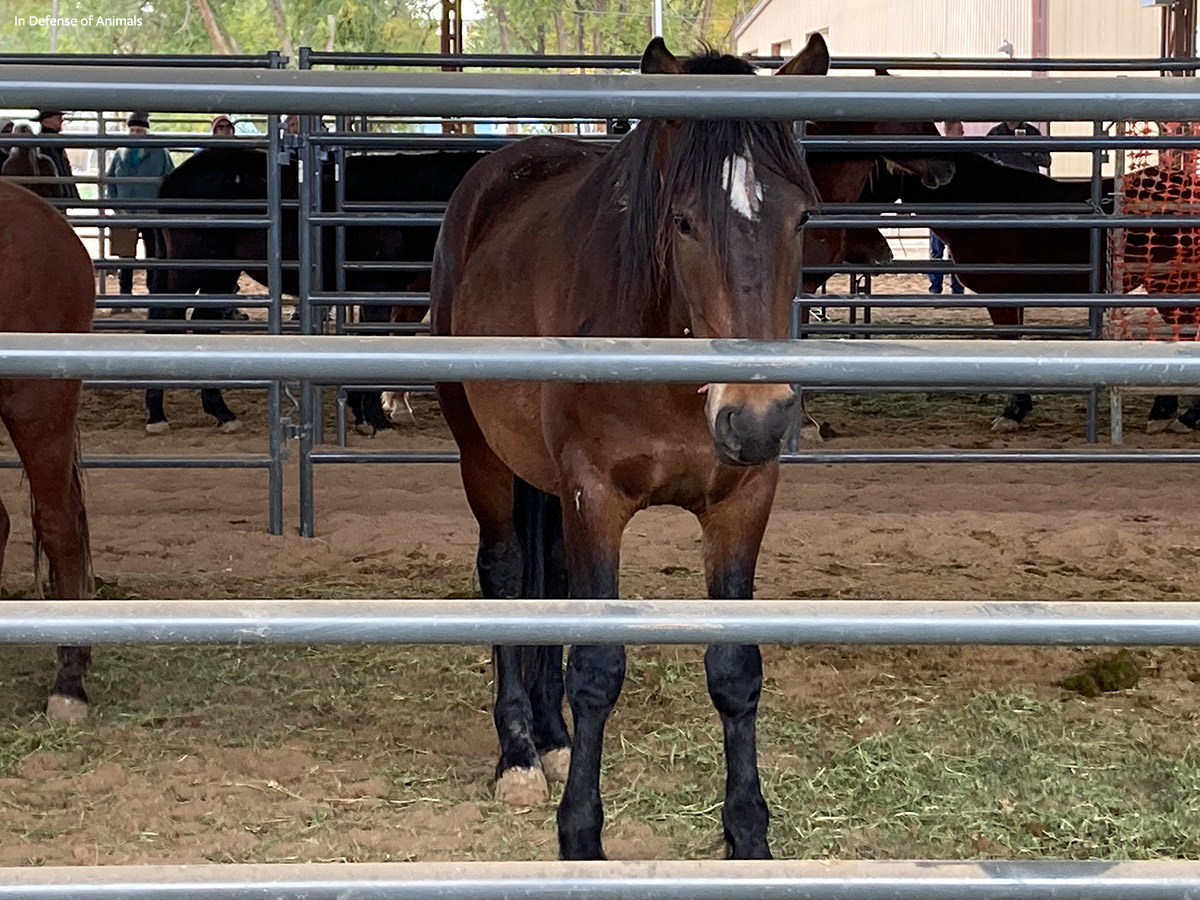
We attended this adoption event to advocate for and continue the story of these Piceance horses from the July roundup. We supported our friends with sanctuaries who were there to save the horses with no bids who usually wind up in bad situations. Horses over age 10, and those of any age that have been offered for adoption three times with no takers, are considered “Sale Authority.” The BLM can sell them outright, with immediate transfer of title, and they are then lost through the system with no transparency. Many of these have been found at “Sale Barn” auctions where kill buyers pick them up for their “worth” as meat, and they are transported to slaughterhouses in Mexico and Canada. At the end of the day, in this auction, all the young geldings were spoken for thanks to caring sanctuaries and adopters.
This strong show of support at this event to provide new homes for these wild horses and burros is an unusual anomaly. As of September 2022, there were about 64,000* rounded-up wild horses in government holding facilities.
In Defense of Animals continually advocates for saving America’s wild horses and burros from roundups and slaughter. A few ways we do this are to bear witness at roundups and sale events, attend educational opportunities and conferences to speak up for them, and collaborate with other advocacy organizations to give them a stronger voice. We inform and educate our Congressional representatives about wild horse and burro issues, and let you, our supporters, know how you can take action. We also encourage people who care about what happens to wild horses and burros to refrain from purchasing products from cattle and sheep ranchers, who make so much money that their financial interests outweigh anyone else’s.

